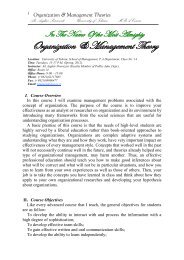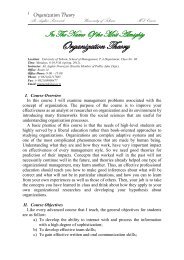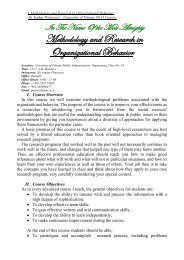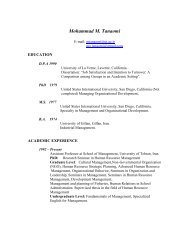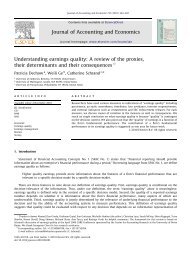Evaluating organizational stress-management interventions using ...
Evaluating organizational stress-management interventions using ...
Evaluating organizational stress-management interventions using ...
Create successful ePaper yourself
Turn your PDF publications into a flip-book with our unique Google optimized e-Paper software.
EVALUATION OF INTERVENTIONS 27<br />
based on an initial problem analysis carried out <strong>using</strong> a risk assessment<br />
questionnaire survey of working conditions. Both studies began with a<br />
simple and traditional pre (Time 1) – post (Time 2) longitudinal intervention<br />
design. Because of the constraints operating within the organizations<br />
involved it was not possible to allocate participants to ‘‘intervention’’ and<br />
‘‘control’’ groups: each intervention was intended to reach all study<br />
participants. In both studies, participants were asked to report on their<br />
awareness of (Study 1) or their involvement in (Study 2) the intervention. In<br />
both studies the dependent variable was self-reported well-being (measured<br />
in terms of levels of exhaustion). Time 2 measures of well-being and<br />
intervention exposure were taken 18 months after the Time 1 measures of<br />
well-being. The evaluation design was adapted by partitioning the<br />
participants groups according to their reported exposure to the intervention<br />
(<strong>using</strong> a Measured exposure 6 Time interaction term) in a repeated<br />
measures analysis of covariance (ANCOVA).<br />
Participants and <strong>interventions</strong><br />
Study 1: Railway staff. Thirty-seven station managers from a railway<br />
transport company provided data at both Time 1 and Time 2. This<br />
represented a response rate of approximately 50% (based on the number of<br />
supervisors providing both Time 1 and Time 2 data). Response rates for<br />
Times 1 and 2, taken separately were higher (68% and 64%). All were male<br />
with an average age of 40 years (SD = 8.0) and average tenure of 14 years<br />
(SD = 7.1) at Time 1. The supervisors worked at different sized stations:<br />
Some stations were larger and busier than others. Inspection of company<br />
records indicated that the supervisors returning questionnaires came from a<br />
representative sample of stations and that they did not differ from the whole<br />
station manager population in terms of average age or length of service.<br />
Some months before Time 1, a central part of the station managers’ role<br />
had been changed. Because of budgetary constraints, their responsibility for<br />
managing the repair of faulty station equipment (including reporting faults<br />
and authorizing and managing repairs 2 ) had been removed. At Time 1<br />
senior managers, not supervisors, managed equipment repair. However,<br />
when the risk assessment data collected at Time 1 was reported, the<br />
organization interpreted these as indicating that the removal of roles and<br />
responsibilities had not been well received by staff. In an attempt to improve<br />
staff satisfaction and well-being, responsibility for managing the repair of<br />
faulty station equipment was returned to station supervisors (i.e., super-<br />
2 This does not refer to track and trains, but rather to equipment found in the station<br />
building. Inspection and repair of track equipment was carried out by other specialist members<br />
of staff.




